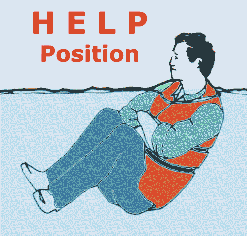Water
conducts heat much faster than air, so expect
to lose heat faster.
The best thing to do is to curl
up into a ball a keep as much as your heat as
close to your body as possible. The image to
the right demonstrates proper technique when
stranded in cold water to preserve as much
body heat as possible.
First
Aid Considerations For Cold Water
Victims
Treatment
for hypothermia depends on the condition of
the person. Mild hypothermia victims who
show only symptoms of shivering and are
capable of rational conversation may only
require removal of wet clothes and replacement
with dry clothes or blankets. The following is
provided by the US Search and Rescue Task
Force.
In more
severe cases where the victim is
semi-conscious, immediate steps must be taken
to begin the rewarming process.
Get the
person out of the water and into a warm
environment. Remove the clothing only if
it can be done with a minimum of movement of
the victim's body. Do not massage the
extremities.
Lay the
semi-conscious person face up, with the head
slightly lowered, unless vomiting
occurs. The head down position allows
more blood to flow to the brain.

If
advanced rescue equipment is available it
can be administered by those trained in its
use. Warm humidified oxygen should be
administered by face mask.
Immediately
attempt to rewarm the victims
body
core. If available, place the person in
a bath of hot water at a temperature of 105 to
110 degrees F. It is important that the
victim's arms and legs be kept out of
the water to prevent
"after-drop".
After-drop
occurs when the cold blood from the
limbs is forced back into the body resulting
in further lowering of the core
temperature. After-drop can be fatal.